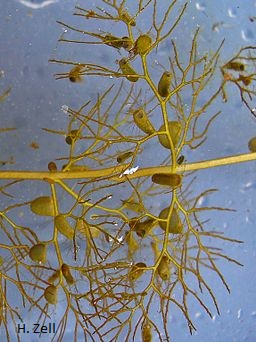
Ecological Importance
Common bladderwort is native to the Northern Hemisphere, and is known to occur in fifty of the United States. It is found in lakes, ponds, wet marshes, and rivers and streams; often in water up to 6 feet deep. Several insects, mammals, and waterfowl use common bladderwort as a food source, and others use the stems as shelter, or to lay eggs.
Problems
Common bladderwort has a habit of growing quickly and intertwining with other aquatic plants, requiring frequent maintenance in ponds. Common bladderwort seldom causes problems within lakes.
Plant Description:
Common bladderworts lack roots but have flowers on erect stems above the water. Yellow flowers emerge above the surface with 3-lobes and a spur underneath.
Underwater the leaf branches or petioles are fleshy and inflated with air which allows them to float. Leaves are whorled with 4 to 10 lateral leaves which fork often giving them a very delicate capillary appearance.
Bladderworts are unique in that the underwater leaves bear small oval "bladders" that trap and digest small aquatic creatures. Bladderworts are usually found in quiet shallow, acidic waters and can form dense mats.
Hints to Identify
Bladderwort can easily be distinguished from other aquatic plants by the small, round, seed-like structures (bladders) that are interspersed throughout the green foliage.
|
Homeowner Treatment Options
|
| Sonar RTU |
| *Aquatic Biologists recommends implementing preventative management techniques and physical removal prior to, or in conjunction with treatment. |
Common Application Questions
Q. How much should I treat?
A. Spot treat as needed to maintain navigation channels and swimming areas. Remember this plant is very beneficial and should not be treated where it is not a nuisance.
Q. When is the best time to treat?
A. Once water temperatures are around sixty degrees or warmer.
Q. How often do I need to treat Bladderwort?
A. Several treatments may be needed throughout the growing season.
Q. How long before I see results?
A. It really depends on the product you choose. For most vegetation, control will take approximately 2 weeks however, tissue damage may be evident within 2 to 4 days with liquid formulations. Some products are slower acting with results taking 30 days or more to achieve.
